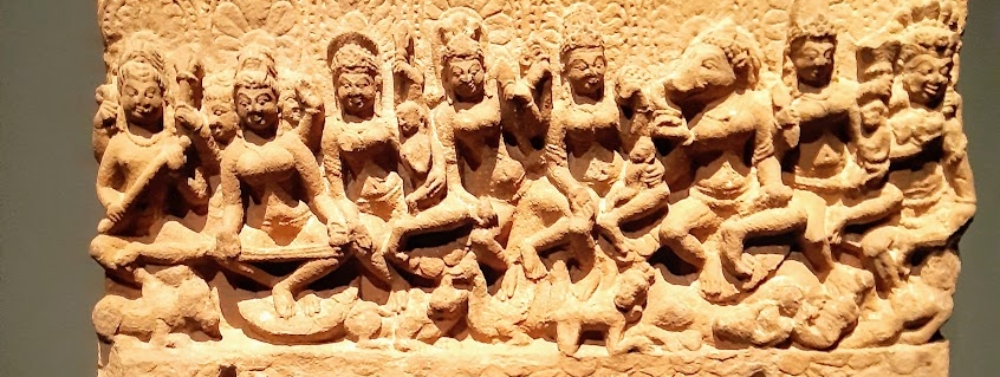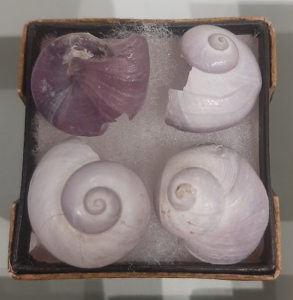
These sea snail shells were excavated from Roman sites near Tyre in Lebanon. The creatures inside were crushed and boiled in a salt solution to produce the famous ‘Tyrian Purple’. It took 10,000 snails to produce just 1.4 grams of dye, making it very valuable and it became the preserve of Emperors, hence its alternative name, ‘imperial purple’. (Pitt Rivers Museum, Various collections)
Mayday/Beltane falls midway between the spring equinox and the summer solstice in the northern hemisphere. The rite of spring has probably been celebrated since time immemorial. In the Western world, in Europe in particular, May 1st will be celebrated by dancing around the Maypole which symbolizes phallic energy. The Maypole is decorated with flowers that represent the buds of fertility and sexual energy.
Beltane is a significant festival in Gaelic culture, alongside Samhain, Imbolc, and Lughnasadh. It was traditionally celebrated throughout Ireland, Scotland, and the Isle of Man. The festival featured special bonfires that were believed to have protective powers. People and their livestock would walk around or between these bonfires and sometimes leap over the flames or embers. All household fires were extinguished and then re-lit from the Bealtaine bonfire.
So what has the colour purple got to do with Beltane and Mayday?
I’ve always loved the colour purple. It’s a unique colour that combines the stability of blue and the passion of red. It’s inspiring to me because it encourages me to reveal my innermost thoughts and feelings. When I think of purple, I’m reminded of how it stimulates my imagination and encourages my creativity. It’s a colour that promotes spiritual growth and intuition, which is something that’s important to me. At the same time, purple also promotes understanding and acceptance. It reminds me that there are so many great unknowns in the world that are waiting to be explored. But even as I explore those unknowns, purple keeps me grounded and reminds me to stay focused on what’s truly important in life.
“4. The deep violet is episcopal. It combines 2 and 3, a bishop being the manifested through the principle of blood or animal life.” (Column XV, King’s Ladder, The Qabalah of Aleister Crowley)
In other words, the colour purple is the bishop of colours, it combines the red of blood and the blue of the sky. Red symbolises blood, fire, love, passion, warmth, lust and sexuality. Blue represents the sky, freedom, intuition, imagination, inspiration, depth, sensitivity and the infinite horizon of the open spaces. And most of all, abundance and balance. When blending the two, purple is created, which allows us to explore and experiment with a range of complicated emotions at once and gives us the freedom to be inspired by sexuality, passion, lust and imagination.
“The colour violet, generally speaking, signifies a vibration which is at the same time spiritual and erotic; i.e. it is the most intense of the vibrations alike on the planes of Nephesch and Neschamah…” (Column XV, The Zodical Attributions: The Qabalah of Aleister Crowley)
The wickedest man in the world, the Beast 666, Count von Zonaref and Alastair McGregor were some of the aliases Crowley used to go by, but every now and then he used the title “The Purple Priest”. The colour purple is used to designate a specific position in the church, such as Bishop or senior Bishop, and by using the title The Purple Priest, Crowley is hinting at his specific position in his church (of Thelema).
Crowley uses the colour purple as an erotic-spiritual motif to convey the esoteric message in the rituals and worship of Thelema.
For example, in Liber Al – The Book of the Law, paragraph 61, we can see how Crowley uses the colour purple in his writings:
“But to love me is better than all things: if under the night stars in the desert thou presently burnest mine incense before me, invoking me with a pure heart, and the Serpent flame therein, thou shalt come a little to lie in my bosom. For one kiss wilt thou then be willing to give all, but whoso gives one particle of dust shall lose all in that hour. Ye shall gather goods and store of women and spices; ye shall wear rich jewels; ye shall exceed the nations of the earth in splendour & pride; but always in the love of me, and so shall ye come to my joy. I charge you earnestly to come before me in a single robe and covered with a rich headdress. I love you! I yearn to you! Pale or purple, veiled or voluptuous, I who am all pleasure and purple, and drunkenness of the innermost sense, desire you. Put on the wings, and arouse the coiled splendour within you: come unto me!”
By using metaphors such as pale or purple, the author might be hinting at the physiology of the lingam. “Pale” suggests a flaccid lingam, and “veiled” could be the stage just before the lingam is fully erect, also it might suggest an uncircumcised lingam. “Purple” suggests its “voluptuous” erection. There are several veins and arteries that carry blood to and from the spongy erectile tissue in the penis. Veins may look larger than usual during and immediately following an erection. The appearance of prominent veins indicates healthy blood flow and gives the lingam a “purple hue.
Next, the colour purple is used to describe “she” who is “all pleasure and purple,” and here the purple is used as a metaphor for the yoni — the purple pleasure…
By using those metaphors, the purple priest emphasises the intensity and depth of the spiritual and erotic vibration in religious-like practices of carnal pleasures. The second half of the sentence – “and drunkenness of the innermost sense,” hints at the ecstatic heights of the orgasm that awaits in the palace (Liber Al 1:51). The Palace is another metaphor for the yoni – see Mogg Morgan’s Aleister Crowley & Thelemic Magick page 39.
In his Hymn to Pan we can see the “purple motif” again:
“…Dip the purple of passionate prayer
In the crimson shrine, the scarlet snare,
The soul that startles in eyes of blue
To watch thy wantonness weeping through…”
There is something very special at this time of the year, the ancient earth dragon, Kundalini, is now fully awakened. The air is fragrant with the sweet heady aromas of many colourful blossoms. Insects, animals and humans alike walk or crawl out of their burrows, rub their eyes, stretch their limbs and start dancing a sensual mating dance. It’s the season to celebrate desire, lust, fertility, or in other words, nature’s tantric celebration.
This is the season of Pan, the “All-devourer, all-begetter”. There is something very salacious about dancing around a Maypole. And by leaping over the Beltane fires, we awaken the most ancient magick of all, the passion for the union of body and spirit — “a vibration which is at the same time spiritual and erotic”.
This is the perfect time to wear the K-23 perfume oil which will connect you to the spirit of Pan and his passionate lust for earth and life. Then, go outside and do the Jitterbug.
The term jitterbug is used to refer to different swing dances, such as the jive and the lindy hop. It comes from slang used in the early twentieth century to describe alcoholics. The term became associated with swing dancers because, like the jitters of alcoholics, they were seen to be out of control.
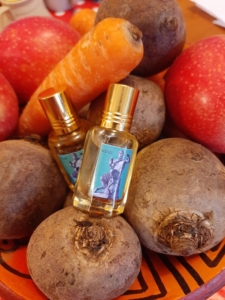
K-23 perfume oil
As discussed earlier in the book, the properties of water allow us spiritual cleansing, where immersion in a ritual bath is always desirable and recommended before magical activity. To connect with the purple magic frequency and awaken the energies of the Kundalini serpent I recommend my special purple bath ritual which is specifically designed to raise our sexual and magnetic powers and to synchronise ourselves with potential or existing partners. Partners can share their bath in the spirit of a purple magick ritual for play, however, here at the Morgan Witches’ headquarters, we prefer to have our ritual baths separately (usually one after the other) and by doing so, each of us has the time to relax and meditate. It takes 15 minutes for our body to reach a general relaxation that allows the blend of oils to work its magick on our consciousness.
Prepare your bathroom as you would any other ritual space, you can have a ‘purple altar’ if you have the room for it, but remember that the altar is the bath, and the water is the vessel which conducts the transformation of the offering which in this case is in the oils and you.
When using the Purple Magick Perfume Oil you can add about 10-15 drops to a tablespoon of sea salt, Himalaya salt or Epsom salts and add it to the bath water. Each of the essential oils suggested here can be used on its own or in combination with one of the other essential oils which are recommended in this chapter. However, mixing and blending essential oils is a form of art and technique that need to be learned and mastered. You can use the recipe at the end of the chapter as a guideline for making your own bath blends.
Make sure that the water is hot enough for you to relax in them for 15 minutes.
Get in the water and lie comfortably, close your eyes, take a few deep breaths and listen to the mantra or music of your choice.
I find that the Kirtan Kriya (Sa Ta Na Ma) mantra is most suitable to listen to in the purple bath ritual.
You can find it here.
If you want to experience the purple magick in its full power I recommend the Great Purple Hoo-Ha meditation while in the bath. The Kirtan Kriya mantra will amplify the experience.
The Great Purple Hoo-Ha Meditation
This meditation is based on a technique described in Phillip H. Farber’s book The Great Purple Hoo-Ha. Philip H. Farber is a writer, hypnotist, NLP trainer, ritualist, and consciousness explorer. He is best known for his book on ritual magick, Future Ritual: Magick for the 21st Century and as the creator of Meta-Magick, a system of practice combining elements of magick, NLP, hypnosis, and more.
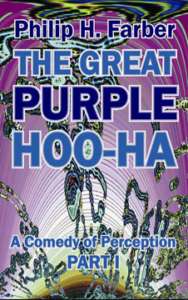
Sit in a comfortable position with your spine upright (if you are in the bath, just make yourself comfortable and relax in the water).
Close your eyes.
Imagine a circle around you, with a diameter just slightly greater than your outstretched arms, with you at the exact centre.
Inhale, filling your lungs completely, from bottom to top.
As you inhale, allow your attention to expand and fill the circle around you with purple.
Exhale, and as you do so place your attention to a tiny spot within the centre of your chest.
Continue to practice like this, filling the circle with every inhalation, contracting down to a single point in the middle of your chest.
When your circle is full of purple, inhale and expand your attention to fill the entire room with purple.
Then, when you exhale, contract it down to a single point in the centre of your chest.
Once the room is full of purple, on the next inhalation expand your attention to fill the largest area you can conceive: the city, the county, the state, the world or even the solar system and the whole universe, with the colour purple. As large as you can manage.
And again, when you exhale, contract your attention down to a single point in the middle of your chest.
When you are ready, open your eyes and return to your regular breathing.
Thank yourself, the water and the oils, climb out of the bath, dry yourself and get dressed (or not) and carry on with your Purple Magick celebrations.
Purple Magick Perfume Oil
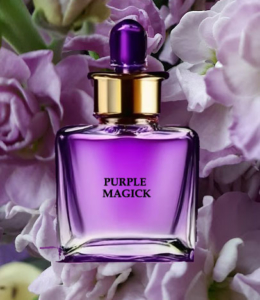
Image created with the collaboration of the Craiyon AI and Photoshop.
The first essential oil that comes to mind concerning Purple Magick, as Scott Cunningham put it “downtrodden Patchouli”.
Even now, most people still associate its sweet musky and earthy aroma with the ‘Hippy’ culture of the 60s & 70s.
So what has Patchouli got to do with Purple Magick?
Patchouli Pogostemon cablin
Patchouli is a bushy herb about a metre high with a sturdy, hairy stem and large, fragrant, furry leaves and white-purple flowers. It is native to Southeast Asia. Once harvested, the patchouli leaves are left to ferment in the shade and then dried for three days. The fermentation process apparently improves the quality of the oil, which is extracted using steam distillation.
In the 19th century, cashmere shawls and bed linen were imported from India to Europe. To keep the delicate fabrics free of moths, they were packed with patchouli leaves, which were used throughout the East as an insect repellent. These Patchouli-scented shawls and linen became a must-have item for well-to-do and fashionable women of the time. It didn’t take long for the Patchouli fragrance to be associated with wealth and indulgence.
The earthy sweet aroma of the plant soon became a trend with many European manufacturers of fabrics and furniture which started to infuse their goods with the scent of Patchouli. It is almost unavoidable to thus visualise and smell the luxurious, heady, musky, scented bedrooms of 19th-century ladies. The richness of the scent has been associated as an aphrodisiac for centuries, the earthy-musky notes make us feel secure, relaxed and open up to our own sexuality. The smell of the bed linen and the furniture infused with Patchouli oil was evocative and sensuous, and the link between Patchouli and sensuality has never been forgotten from our collective memories of those 19th-century bedrooms.
So next time you watch a period drama or read a novel about this period, and you want to intensify your experience of the novel/drama, make sure you have a bottle of Patchouli at hand so you can smell it during the bedrooms scenes or whenever a cashmere shawl appears.
The sweet and heady scent of the Patchouli blends perfectly with the exotic fragrance of Ylang-Ylang. On its own, I find Ylang-Ylang a bit overpowering and far too sweet, but the earthiness of Patchouli seems to anchor the sweetness of the Cananaga odorata and turn it into a somewhat lighter and mysterious exotic fragrance.
Ylang-Ylang Cananaga odorata
Ylang-Ylang is a tall tropical tree with large, tender, sweet fragrant yellow flowers. It is native to Southeast Asia. Its essential oil is extracted by water or steam distillation from freshly picked flowers. There are 5 grades of distilled essential oil, with Ylang-Ylang extra as the top grade.
The sweet, exotic-balsamic scent of Ylang-Ylang will balance and calm an overactive mind or any over-emotional state or feelings. In Indonesia, its fragrant flowers have long been associated with aphrodisiacs. To promote a relaxed and sensual atmosphere, fresh Ylang-Ylang flowers are harvested and spread on the newly wedded couple’s bed.
Both Ylang-Ylang and Vetiver are under the planetary influence of Venus, the goddess of love, beauty and sensuality. Together they combine two of her most precious elements, the stability of the earth represented by Vetiver and the fluidity of water represented by Ylang-Ylang. On the emotional, physiological and magical level, these two oils blended together act as the psychic lubricant of body and mind. Once the harmony between these two Venusian oils has been established we can introduce Jasmine, the “King of flowers” to the formula (Cunningham: 1997). Jasmine is known for its qualities as a sexual tonic and aphrodisiac. The intensely rich, warm and sensual, sweet floral scent, has a direct effect on our emotions and can produce a feeling of optimism, confidence and euphoria. Its association with the moon will add a silvery reflection to a sensuous magical rite, where there is a union of lovers. Its elemental characteristics of both fire and water will intensify the sacred sexual union with a magical oomph of flowing passion.
To balance out the richness of the sweet and heady aroma of the blend I added a few drops of Bergamot. The fresh and fruity, citrusy scent of the oil, is just sharp enough to break the nearly overwhelming sweetness of the heady blend.
Bergamot Citrus bergamia
This small tree, about 4.5 metres high with smooth oval leaves, and small round fruit, ripens from green to yellow, similar to orange in appearance but smaller. Native to tropical Asia. Extensively cultivated in southern Italy, Sicily and the Ivory Coast. Essential oil extraction is by cold expression of the fruit’s rind.
Safety data: Certain furocoumarins, notably bergapten, have been found to be phototoxic on human skin; that is, they cause sensitisation and skin pigmentation when exposed to direct sunlight.
The scent of Bergamot resembles that of orange but with more floral and zesty underlying characteristics that add a spicy edge to it. Bergamot possesses magical qualities that can alleviate nervous tension and physical stress, acting like a wand by lifting, shifting, releasing, and dispersing these feelings. Bringing peace and happiness and creating a space allows both body and mind to rest and relax. The lightness and uplifting touch that Bergamot adds to the blend, accentuates each of the other fragrances and mixes them together into a bewitching sensual perfume which will work both ways on its wearer and their partner.
Purple Magick bath recipe:
In a small bowl, mix 1 tablespoon of sea salt, Himalaya salt or Epsom salt,
1 drop of Patchouli
1 drop Ylang Ylang
2 drops of Jasmine
3 drops of Bergamot
For your safety, I recommend using the following recipe for a night-time bath due to the sensual nature of purple magick and the potential risks associated with Bergamot essential oil.
It’s important to note that the Purple Magic Perfume Oil is safe to use as it contains bergapten-free essential oil.
***
Purple Magick – Mayday/Beltane is an extract from my soon-to-be-published book Aromagick – A Scentual Journey Through The Ritual Year.
For any inquiries about the Aromagick perfume oils series, please contact Mandrake at https://mandrake.uk.net/contact/
Have a fabulous Purple Magick season
Diti J Morgan
